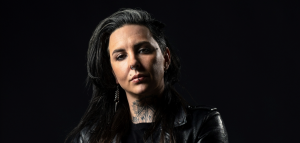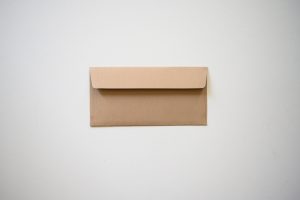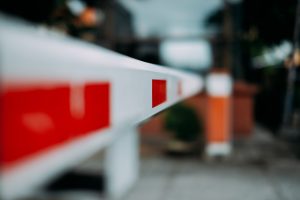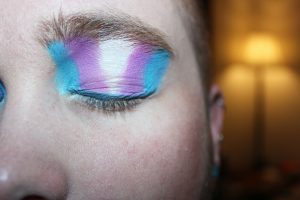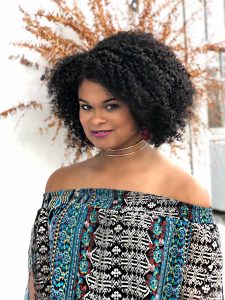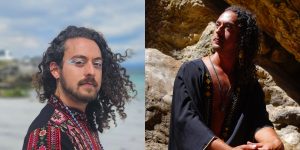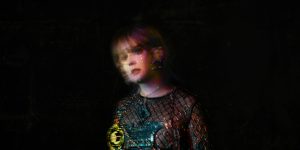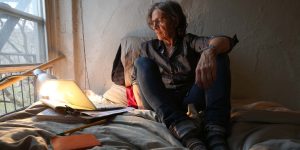Archer Asks: Five queer artists on superheroes, erotica and top surgery in art
By: Anna Hu
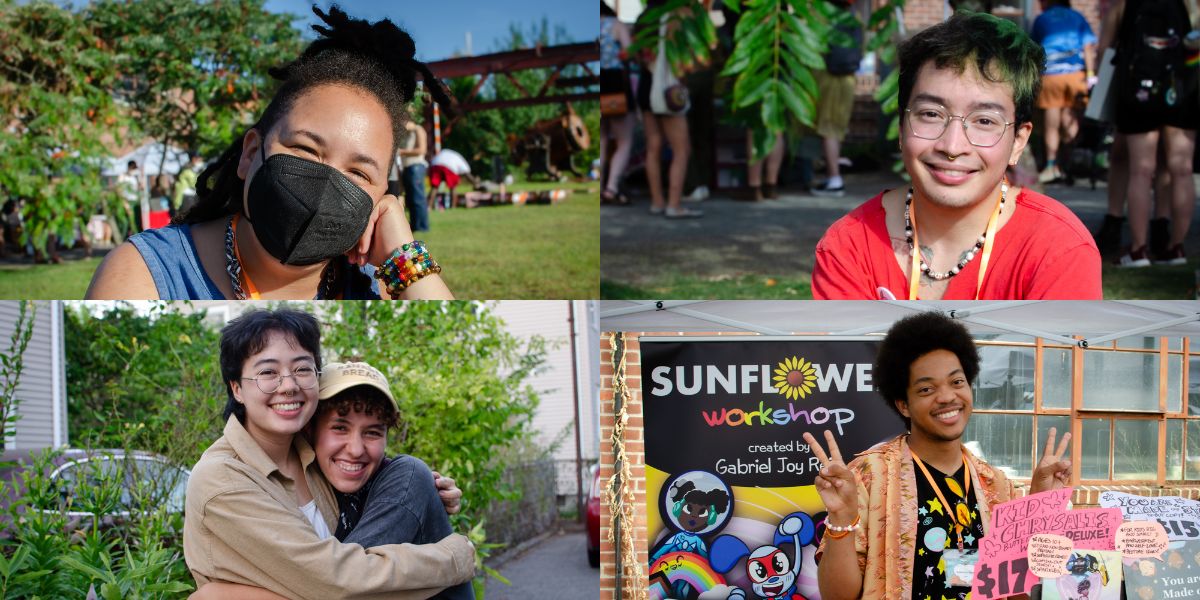
For five years, the Queer/Trans Zine Fest, hosted outdoors in Providence, Rhode Island, USA, provided a space to boldly celebrate queer art and artists. This year was the last iteration of the beloved festival, which hosted thousands of attendees and over 70 exhibitors across the free, six-hour event.
The festival was dreamed up by nine friends in 2017 and it expanded with each run, experiencing a resurgence in interest after a several-year hiatus around the height of COVID-19.
The founding group of friends, themselves queer artists, wanted to create an inclusive and supportive environment by making it financially accessible to exhibit, providing travel stipends, table setups and lunch. And while the event is called a zine fest, the art on display went far beyond the traditional zines, also including prints, stickers, buttons, ceramics, books, and jewellery.
While at the festival, I spoke with the following five artists on everything from why being a superhero is like being queer, exploring top surgery through art, and the legacy of the Queer/Trans Zine Fest:
Gabriel Joy Reid

Image by: Anna Hu.
Gabriel (she/they), who also goes by Joy, is an artist who wears many hats – writer, illustrator, cartoonist and filmmaker. They are also a student at Boston University pursuing a master’s degree in Visual Narrative, which they say is just a fancy name for comics.
We spoke about her trans superhero comic, the connection between being queer and superheroes, and coming out.
Anna Hu: First things first, could you introduce your art journey?
Gabriel Joy Reid: I started making comics in the summer of 2020. I mean, I’ve been drawing and doodling all my life, but I’ve kind of used that as a coping mechanism, I guess you could say.
During the summer of 2020, when the pandemic hit and the Black Lives Matter protests were in a resurgence, I made a comic about the intersection of racial justice and mental health – kind of a starting off point to talk about these kinds of things. It was for my class originally, and then everything happened and I was like, maybe I should put this out there.
Ever since then, I’ve just been making comics. And while I do a lot of things, I really enjoy the comic-making process because it’s just so accessible. Comics are actually a lot like zines – anyone can make their own. You just need a piece of paper and pencil, and you can fold it. Most people can find printers, too. There’s a deep history of activism through zines and comics.
I make a lot of work about Black experiences, queer experiences. A lot of the stuff I make is aimed towards middle grade and young adult readers. I’m making a lot of the books and stories that I wish that I could’ve had when I was growing up.
AH: Like, for your younger self?
GJR: Yeah, for my inner child, absolutely. A lot of comfort character stories.
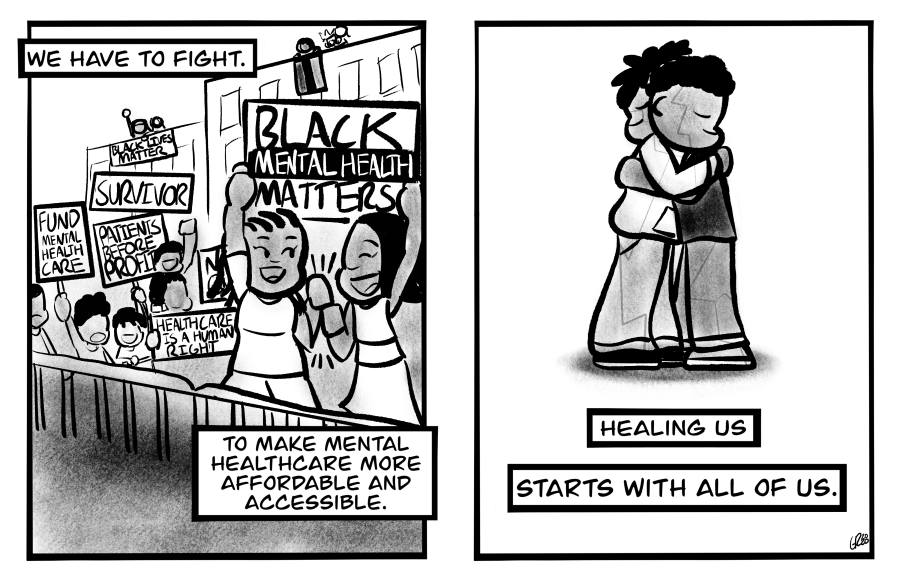
Artwork by: Gabriel Joy Reid.
AH: In that line, tell me about Butterfly Girl.
GJR: Yeah, sure. So, Butterfly Girl is the main character of my webtoon called Kid Chrysalis, Butterfly Warrior. It’s about a trans non-binary superhero. Their name is Chris Caden, and they also go by Butterfly Girl. It’s all about them coming out to their dad, who’s also a superhero.
The comic is based on my own coming out experience to my dad. I love superheroes so much – especially characters like Spiderman who have their own secret identity that they can’t reveal to anyone. If they do reveal their identity, they could be in big trouble, and someone they love could be in big trouble, too.
When engaging with these narratives, I was like, Wow, that’s a really trans experience, actually. You know, especially if you’re closeted, or you can’t come out to everyone, it can be a really big deal when you do. So, I kind of use that as a starting point and created this world around that.
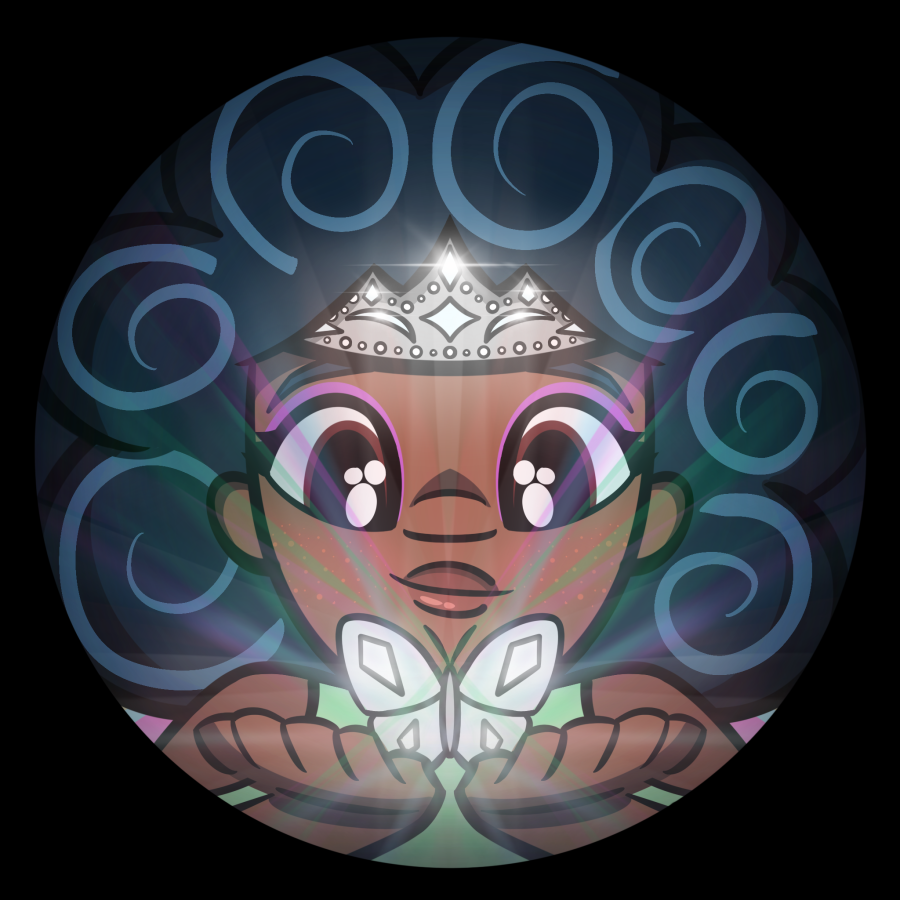
Artwork by: Gabriel Joy Reid.
AH: And it sounds like people have really been responding to that character, and to the comic in general.
GJR: Sure. I want to continue making more stories based off of it as well. It’s been really cool to have people say, “Wow, I see myself in the story.” Or like, “I understand this experience.” The conversations between the characters of Dad and Chris are based on real conversations I had with my own dad, and apparently a lot of people had with their parents, too.
I want to continue to make a lot more stories like that, especially focusing on Black trans experiences. I feel I see more trans stories now, but not a lot of them have that intersection of a Black identity or person of colour identity – it’s like there’s another element of safety or worry that might be around parents when you come out.
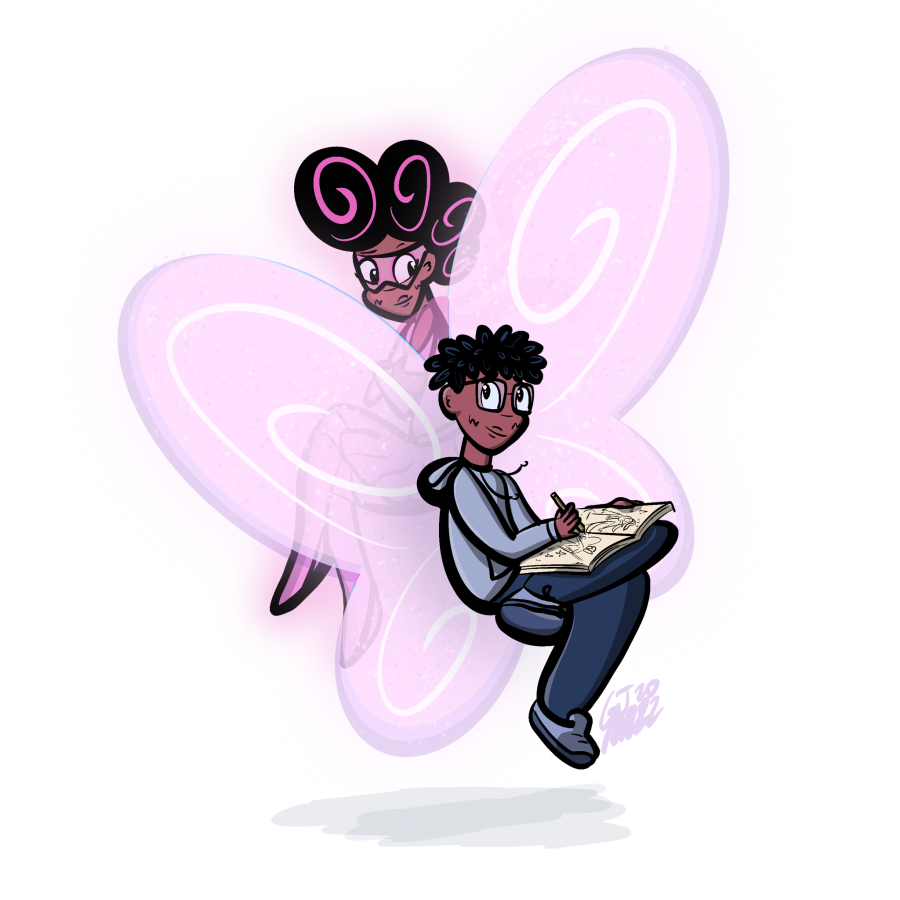
Artwork by: Gabriel Joy Reid.
AH: What do you want people to take away from this comic?
GJR: So, the main theme of the comic was just how far support and allyship goes, not just acceptance alone.
Acceptance is one thing, saying, “I’m okay with this,” but being able to go along with someone’s journey and the coming out process, being helpful and standing by their side through it all is more than that. Coming out is messy; it doesn’t have to be perfect. You know, usually it’s not perfect, but even that is okay. We’re all working together on this.
I showed the comic to my dad last year and I kind of thought his reaction was going to be worse for some reason, but the very first thing he said was, “We got to get someone in Hollywood to make this movie.”
AH: That’s a good reaction!
GJR: And you know, he’s always tried to be an ally. He used to be a lot more conservative with his viewpoints. But he’s changed over time. Now I go to Thanksgiving dinners and he’s always the one defending drag queens and trans people. I’m like, “Dad, whoa, where did this come from?”
I came out to him during the pandemic, in 2021. I was always a little different. I never knew how to describe it. Because of that, I was very insecure when I was growing up.
Then I went to college – I’m from Kansas City, but I went to Northeastern University for undergrad, and now I’m at Boston University. Ever since going away from Kansas, I was able to kind of find out what words describe me, and the label that feels comfortable. That confidence really helped me to figure out how to word my experiences.
It’s still been a journey, and it’s not always easy. I just came out to my grandma this summer, and that was crazy. That was a very emotional experience. But overall, you know, she’s very accepting and I was like, Wow, even more stories than I can tell.
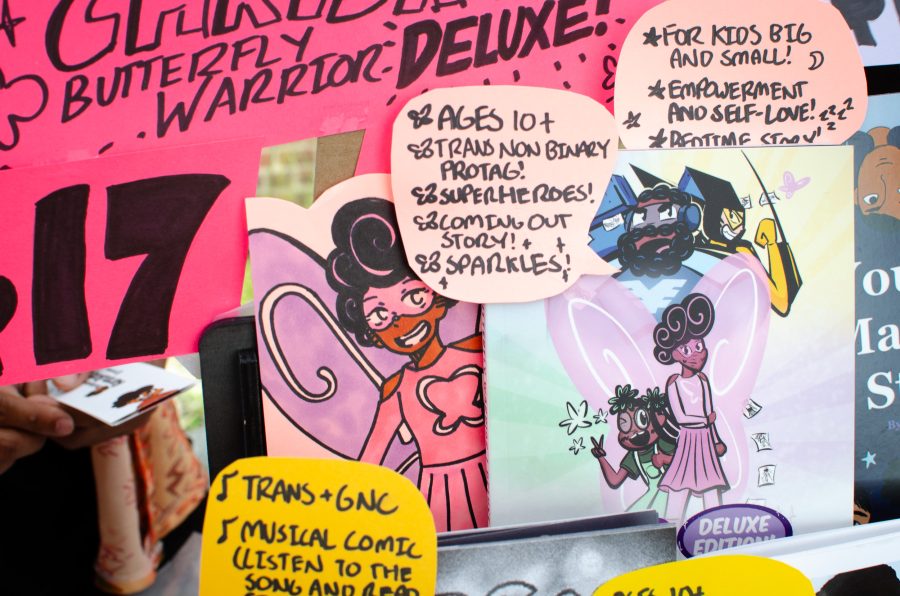
Image by: Anna Hu.
Marius Keo Marjolin
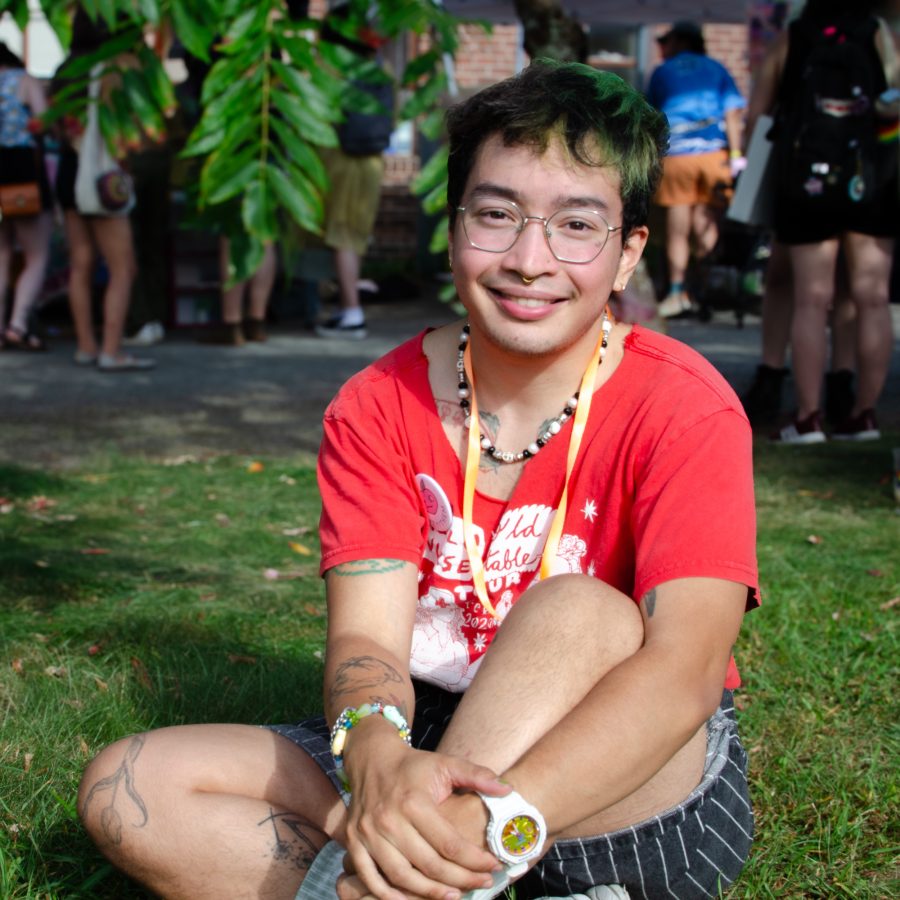
Image by: Anna Hu.
Marius Keo Marjolin (they/them) is an illustrator who graduated from the Rhode Island School of Design’s printmaking program in 2021. Having just moved to Boston and started a master’s program at the School of Museum of Fine Arts, Marjolin also identifies as a tired graduate student. Through the program, they are hoping to expand their artistic skill set beyond 2D illustration into larger scale installations and sculpture, while still maintaining their zine community roots.
We spoke about their Cambodian-American heritage, the influences of cultural folklore on their art, and their upcoming comic about top surgery and a supportive ex/best friend.
AH: To start, I’d love to know about some of your artistic influences.
Marius Keo Marjolin: I’m Cambodian-American, and so part of my work explores visual motifs and characters from my folklore.
I like interpreting these characters who were often depicted in plays, ballets and visual art into my own work – which is very much visual, but has kind of a punk lens and a comic-y lens. Not the most eloquent way I could have put it, but I guess I’m kind of interpreting these folklore themes and translating them into my own language as a contemporary Cambodian-American person.
AH: What are some examples of motifs that you’ve been drawn to?
MKM: I really am drawn to the naga, which is this type of serpent. That’s a creature I’ve come back to over and over again because I think, in some sense, dragons are pretty universal.
But I like exploring the specific ways that these mythical creatures or characters occur in my culture. I’m really drawn to the character of the Monkey King or Hanuman. I have a print that depicts Hanuman as this person in a punk jacket with a patch that says, “Abolish the Police”. I think I’m interested in exploring him again, as a folk hero, but through a modern lens.

Artwork by: Marius Keo Marjolin.
AH: In one of your artist bios, you talked about a Khmer futuristic fantasy world. Can you talk a bit more about what that looks like to you?
MKM: It’s something that I’m really trying to explore more now. As far as my artistic influences, I’m really inspired by fantasy, sci-fi and genre fiction – things that are often considered low art as far as storytelling goes on. Especially now, I’ve been interested in solar punk fiction as well, as far as like, how do we live in a world that often feels kind of pre-apocalyptic?

Artwork by: Marius Keo Marjolin.
AH: Are there any projects you’ve been working on recently that you’ve been really excited about?
MKM: I’ve been honestly working on a lot of comic projects and zines recently. Before that, I was mostly making poster-size screen prints, but I think being able to make a book, like a narrative, has intrigued me.
Currently, I’m actually working on an autobiographical comic. It’s about my top surgery recovery, which is interesting because it happened in the middle of a major breakup with my partner of four-ish years, who also took care of me while I was recovering. Essentially, we were in the process of figuring out that we needed to move on from our relationship, but going through top surgery put that process on hold for a second.
When you’re recovering from top surgery, you cannot really raise your arms above your head. You literally need to have someone to help you dress, wash and all of that, for like two weeks at least. And my partner did all of that for me. There’s something really interesting in exploring that intimacy – of having to put feelings aside to take care of another, while still leaving a lot unsaid, too.
AH: I’m glad you were able to have that support.
MKM: Yeah, for sure. And me and my ex are still best friends. So, she’s been super supportive of me working on this comic.

Artwork by: Marius Keo Marjolin.
AH: In your bio, you also mentioned the importance of finding a queer community. What has that process been like?
MKM: I came out as non-binary first on the internet as a middle schooler on Tumblr, or whatever. Then I guess I came out more formally in high school.
I really didn’t have a lot of other queer people in my life up until I started seeking them out. And my queer identity is often kind of changing a little bit; I still feel very much like a shapeshifter, as far as the way that I navigate gender and sexuality. Those things still feel amorphous to me, which is fine.
AH: Are there any specific ways you feel like things have been shifting?
MKM: Yeah. I think I spent a lot of time identifying as sort of transmasculine in college. And then only recently I’ve kind of been drawn more towards being a dyke, honestly. I had a lot of transmasc friends in college who were – rightfully so – trying on a certain idea of manhood that was pretty cis-normative, and I really just did not resonate with it.
And so, I had a reset at some point and just decided, I think I’m some butch boy dyke thing, which made me feel a lot better.
Des Bennett

Image by: Anna Hu.
Des Bennett (they/them) is a Black, trans artist based in Boston. They started collaging in middle school as a way to process the world, and haven’t looked back since. While they work as a theatre producer full-time, they also use their background in art to produce collage pieces and zines, and now also to teach zine workshops.
We spoke about being a self-taught artist, where to find the best collaging materials, and the freedom and accessibility of zine-making as an art form.
AH: Can you start by introducing yourself and your art?
Des Bennett: So, I really started collaging when I was in middle school, but I also have a background in drawing. I’m mostly self-taught. What I love about collage is that it’s so accessible. To me, it’s one of the most accessible ways to make art and is also environmentally friendly – I love being able to reuse items that have cultural history or context, and remake them.
A lot of my art explores the lines between reality and unreality, and dreams versus waking life. It explores a lot around rage, grief, ecology and eco-disaster, identity as a trans person and as a Black trans person.
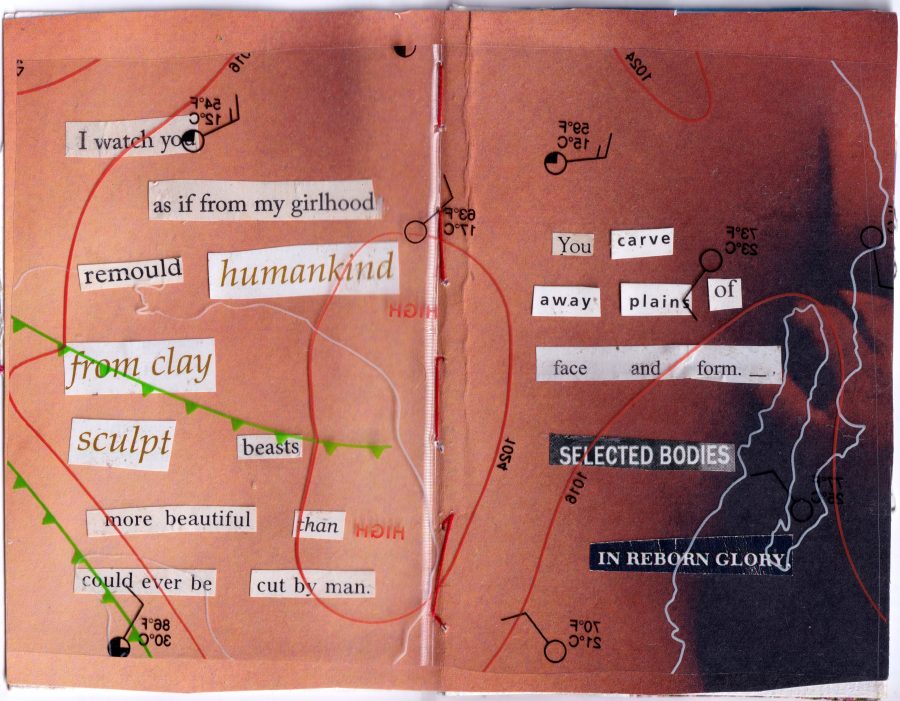
A spread from the zine The Man Is A Parody by Des Bennett. Found poetry and collage, plastic overlay.
AH: And what has your journey with art been like?
DB: I feel like most of my history as an artist has been me holed up in my room making things. A lot of my art stems from art journalling and processing. I’m not trained in any way; I went to school for theatre and work as a theatre producer.
The art that I’m sharing today at the Queer/Trans Zine Fest is so much more personal. It’s the thing I do to help process the world around me.
I have long struggled with a dilemma: do I want to be an artist that sells my work and then is somewhat beholden to the people who are buying my work? Or do I want to just do art for me, and for the sake of my own growth, and the way that making art makes me feel whole?
I feel like zines are the way I’ve been able to resolve that, and to marry my arts practice together, because they’re so cheap to make.
It’s one of those things where I can put my heart and soul into something and really easily share it with some other person, and not feel like, I don’t know, it’s the end of the world if someone doesn’t like my zines. And so, zine-making gives me a lot of freedom in terms of being an artist who sells my work.
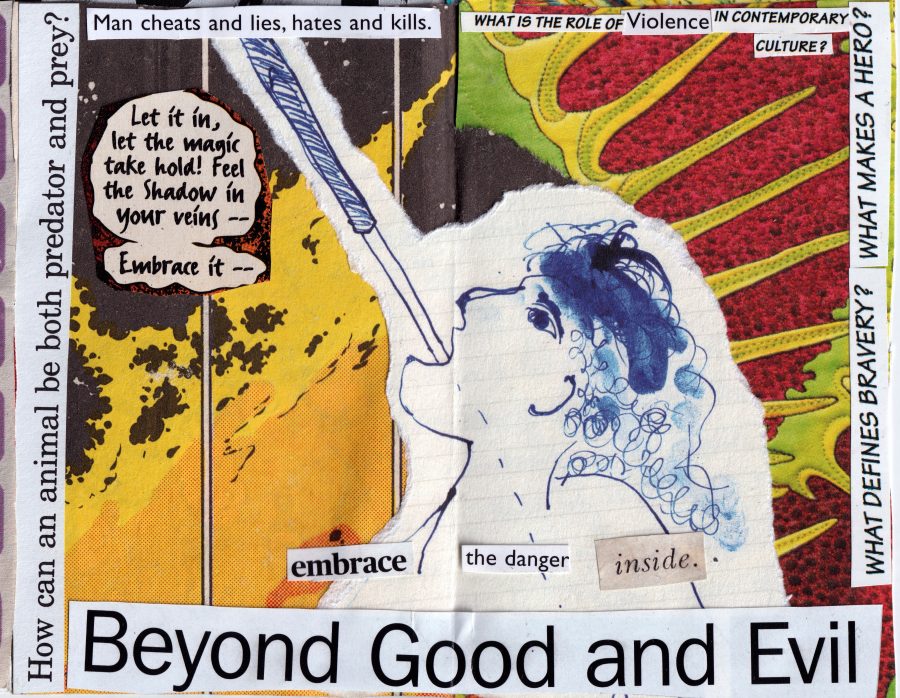
A spread from the zine The Year of the Villain by Des Bennett. Found text and collage.
AH: I’m curious – in collage making, where do you get your raw materials from?
DB: Yeah, that’s the most common question I get. Part of finding materials is to look differently at things that you’re reading. You have to look closer and imagine what something can be, rather than what you already see it as. But I run through National Geographic like no one’s business.
My favourite resources come from used bookstores that have photography, art books or encyclopedias. And I find a lot of stuff with spacey or nature vibes. Portrait books are really helpful, too.
I look for queer aesthetics, but I feel like that’s what I struggle to find the most. It’s hard to not only find things that have queer aesthetics or feature queer people, but also things that I feel comfortable cutting up. Because these materials are also archives. I have bought some queer publications specifically to collage with, but I get them in the mail and I’m like, I can’t… I cannot cut into this.
With collaging, a lot of what I’m doing is remixing things into a queer context. I’m adding top surgery scars, for example. I mean, there are no rules in collage.
If you were a ‘weird Barbie’ kind of person (I was), that is what I’m doing. It’s fun because I can do things that are hard to achieve in real life: I cannot so easily have top surgery scars. And so, it’s also for me to look into my own future and make that visible.
Today at the Queer/Trans Zine Fest, somebody was like, “I’m going to pick up this zine because I’m about to get top surgery and I’m really nervous about it.” And that was it. That’s exactly that’s what the zine was about: I’ve waited to become this thing that I want to be, but I’m scared of becoming a parody of a man. I’m scared of becoming a parody of myself.
It’s just really affirming to have these connections translated through art. Those moments are beautiful.
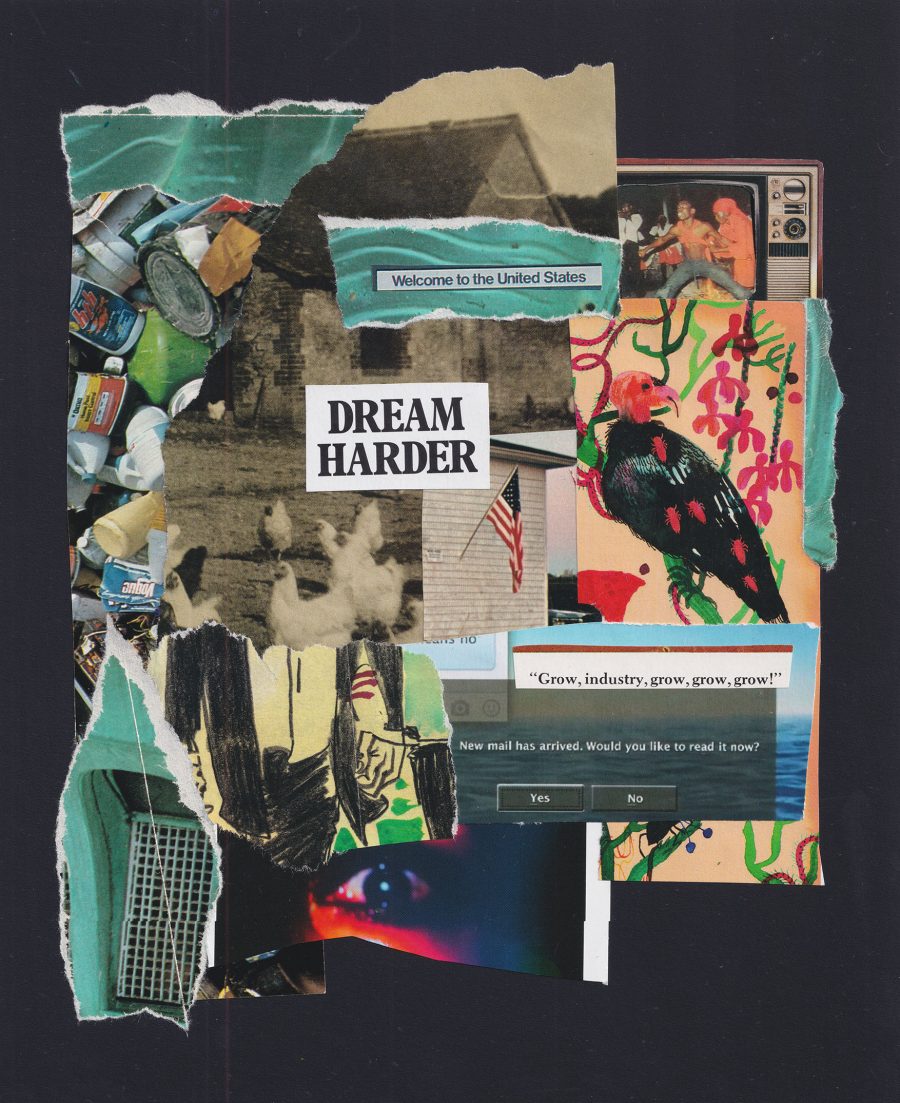
Dream Harder by Des Bennett. Collage on cardstock.
AH: In general culture, collaging is portrayed as something that, you know, teenagers do in their bedrooms…
DB: Yeah. Which is me.
AH: But do you agree with that characterisation? Do you feel like you want to push back against it at all?
DB: I think it’s interesting because I feel like what you’re getting at is: what’s real art? What’s considered real art? I feel like I used to get really in my head about whether collage was real art, especially when I’d go to a big art vendor or gallery and feel like, “Wow, you’re a beautiful illustrator, and I can’t do that.”
But to me, I feel like it’s just a different type of skillset. Art that is accessible to youth is no less valid just because it’s something that everyone can do.
I’ve taught so many collage workshops and classes to so many different types of people, and everyone collages differently. And it’s less about skillset and more so, in my view, about how your mind works.
I’m working from trying to translate memory or dreams or these kind of ephemeral things into images, but sometimes people are trying to actually make something look as real as possible with collage, and I think that’s its own artistry. I think collage is inherently rebellious because it’s taking materials and ripping them up and saying like, I don’t know, fuck the binding.
It also really messes with that white supremacist idea of the value of the written word. It kind of knocks that out of the park. So, I think it’s a rebellious thing and that’s why it’s connected to teenagers or—
AH: I feel like, every queer person.
DB: Yeah, every queer person, punk scenes. That’s what it’s really saying, like, Okay, I’m going to take this stack of popular culture or whatever’s accessible because there aren’t publications about X, Y, Z, marginalised topic or identity. I’m going to take this and make it mine.

Image by: Anna Hu.
Jules Kang Sharpe & Madison Tom

Image by: Anna Hu.
Jules Kang Sharpe (they/them) and Madison Tom (they/them) went to the Rhode Island School of Design together, graduating in 2023 from the illustration program. They both make comics, illustrations and zines, working often with risograph printing. Jules is now a teacher, illustrator and freelance printer based in Rhode Island. Madison works as a designer at a wallpaper manufacturing company, and is based in Connecticut.
We spoke about their senior year collaborative project, getting personal through abstract art and queer erotica.
AH: Can you talk about how you know each other?
Madison Tom: Yeah, we went to school together. We were in illustration at Rhode Island School of Design together. We had desks that were right next to each other senior year of college, and so we became collaborators on a project.
AH: What project?
MT: It was a collaborative study project, which was a one-month long winter course. You just make your own projects with your friends, basically. And so, we made a zine about a fictional Boy Scout troop, and we made merch for the Boy Scout troop, like bandanas and T-shirts. And then we had a sale at the end of the course. It was very sweet.

Artwork by: Jules Kang Sharpe.
AH: Can you both describe your art styles?
Jules Kang Sharpe: I like to use a lot of pen and ink, mostly. I like to draw traditionally and I sketch a lot.
I print all my work on the risograph, and I feel like that informs a lot of how things might look. Usually, I colour digitally, too, but I separate all the layers out and then print with the risograph.
MT: My turn! I also have a digital/traditional blend of work. I do a lot of my line art traditionally, which can be pen and ink, or I’ve been doing a lot of graphite stuff lately. And then I scan it and colour it digitally.
I used to use the risograph a lot, but I don’t have access to one anymore, because I’m out of school and not in Providence anymore. My stuff can be detailed, or it can be sillier, just depending on what I’m feeling like doing that day.
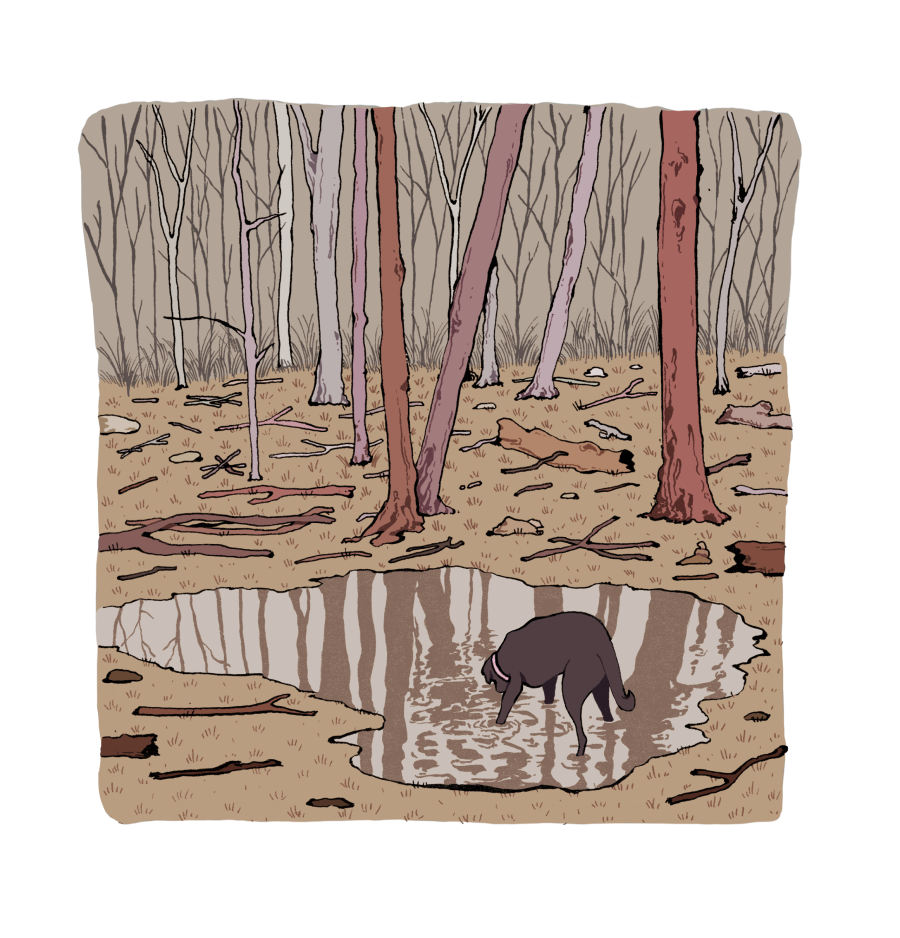
Artwork by: Madison Tom.
AH: Madison, can you tell us more about your personal projects?
MT: Yeah. How do I explain it? I’m also kind of shy about talking about my work, or what I really mean. I do a lot of work where I use writing and stuff, so I like to blend images and writing. I try to keep the writing vague, but also it’s very specific to me. I feel like I really don’t know how other people interpret it.
With my last two zines, I had one called Young Forever. It was about relationships – like friendships – and how you can feel so happy in a relationship, and then one thing can happen, and everyone can leave you. And it’s really sad, but then you have to find your own way out of it. I had images of birds going on power lines and they all come in and join, and then they all leave at some point. And then at the last image, the one remaining bird leaves, too.
And then my most recent zine is called A Good Man, and it’s about my dad who died seven years ago, but, you know, we’re still dealing with that. Nothing really sparked it, I was just thinking about him, as I do, so I wanted to make a zine about it.
My images are often completely different from the words that I’m writing, or they’re based on a different theme that kind of goes along with the theme of the writing, but not explicitly. I like to keep it personal, but also not too personal.
AH: There’s a layer of separation.
MT: Yeah, it’s kind of like I shroud what I really mean with these images.
AH: Have you ever talked to somebody who’s seen one of your artworks and had a connection to it?
MT: Oh my god, I was telling Jules this. I had my Young Forever zine with me when I went to Buffalo a couple of weeks ago, and this woman picked it up and she started tearing up. I was like, Oh my god. And then she was like, “Yeah, it would be too long to get into the story of why this made me feel so emotional, but I really enjoyed reading this. It was really beautiful.”
This zine is very specific to me because one moment in my life sparked it. But to hear that someone else can have, you know, an entirely different set of experiences and still feel the same way that I do is really crazy.

Artwork by: Madison Tom.
AH: Jules, can you tell me about one of the projects you’ve been doing recently that’s been really exciting for you?
JKS: Yeah, I just finished publishing a comic yesterday, right before this fest! It’s an erotica comic. I have been wanting to make more erotica because I feel like most of the stuff that’s out there is made by dudes, and is about very strange and predictable conflicts.
So, I wanted to make erotica that was more imaginative, and it’s trans, too.
But it definitely took a really long time. When I started it, I didn’t quite realise how intense it was going to be.
AH: And have you seen any kind of response to it, the one you just published?
JKS: I feel like people seemed excited about it.
MT: It’s awesome!
JKS: Thanks, man. Yeah, I feel like people have been pretty supportive. I definitely feel self-conscious, I don’t know, like, this is my erotica tale. But I also think that there’s so much of that content around that I don’t think it’s really that big a deal.
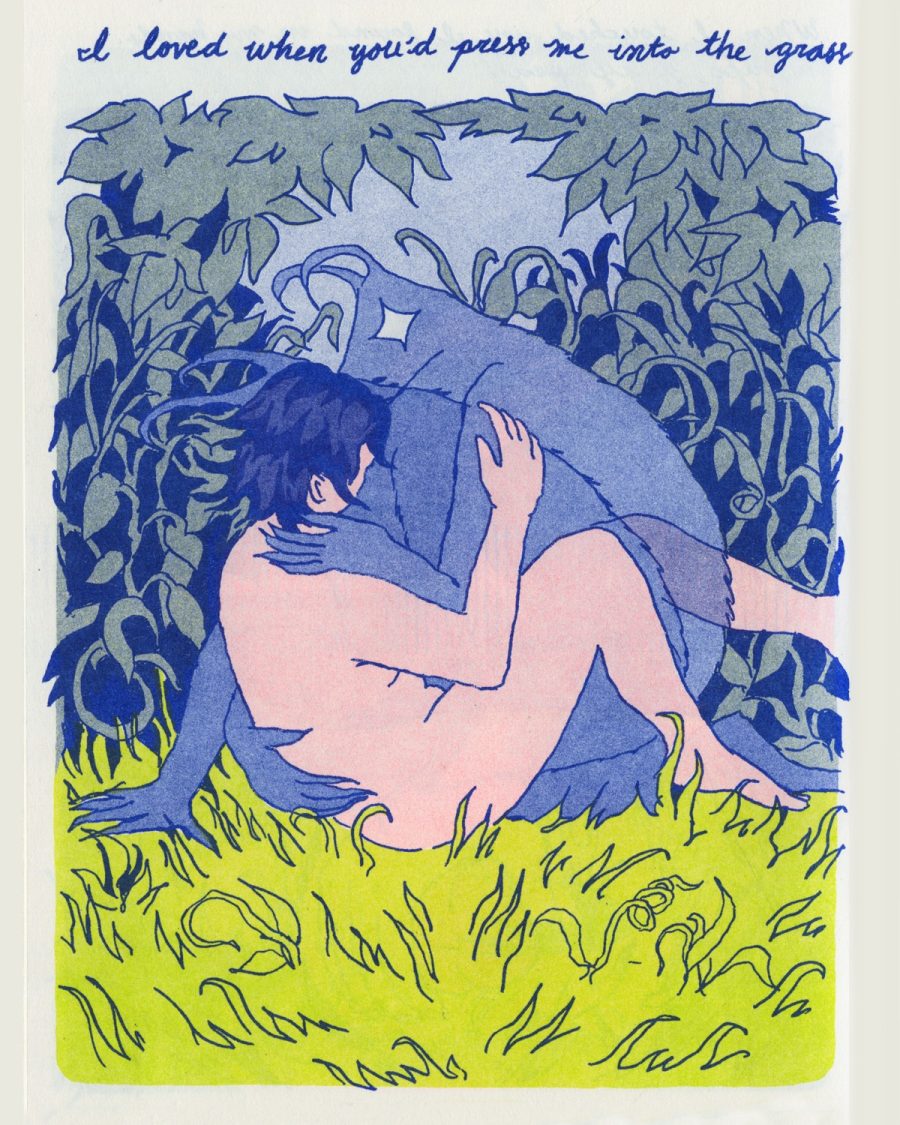
Artwork by: Jules Kang Sharpe.
AH: Have you both been to this festival before?
JKS: Yeah, last year was my first year.
MT: Mine too. And we had tables next to each other last year, too.
AH: That’s so cute! Were you able to request that?
MT: Yep. Like, I want to sit next to Jules, please!
AH: Now that it’s the last year, and reflecting back on how this is maybe different from other festivals you’ve been to, what are your general impressions of the Queer/Trans Zine Fest?
MT: Yo, they are so nice to us. I think it’s one of the most well-run zine fairs that I’ve ever tabled at. They give you travel stipends, they provide you lunch…
JKS: There’s also an optional tabling stipend – like, you can get money to be an exhibitor.
MT: They’re so generous, and it’s so amazing. Other places you pay for a table, or you bring your own.
They’re just one of the best run fairs. They worked so hard to make sure that it’s the best experience for the exhibitors. I mean, it’s probably easier to not offer as many things, you know? But they really went above and beyond.
JKS: They’re really good about COVID consciousness, too.
I’m definitely sad that it’s the last year, but I’m also like, I think it’s cool that they went so hard for the times that they did have it, and then you can look back at it as a really well-done event. Maybe it could set the standard for other fairs, too.
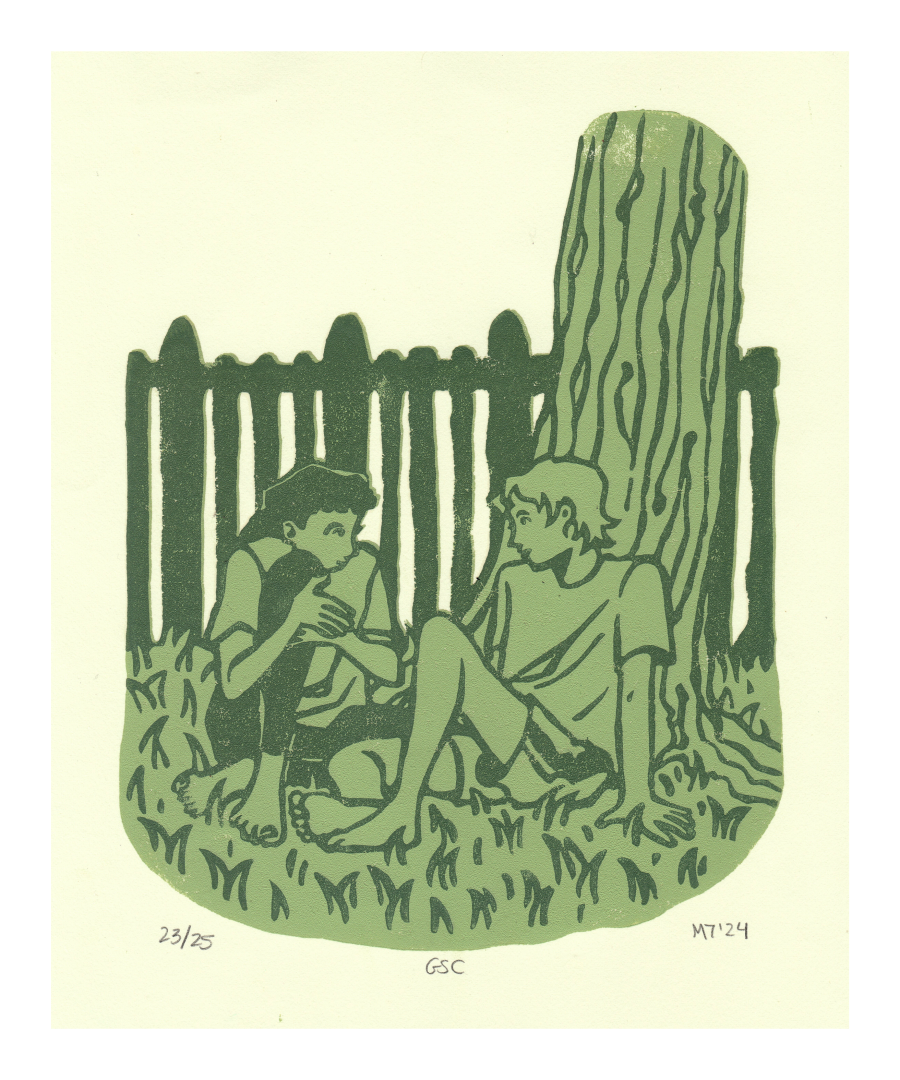
Artwork by: Madison Tom.
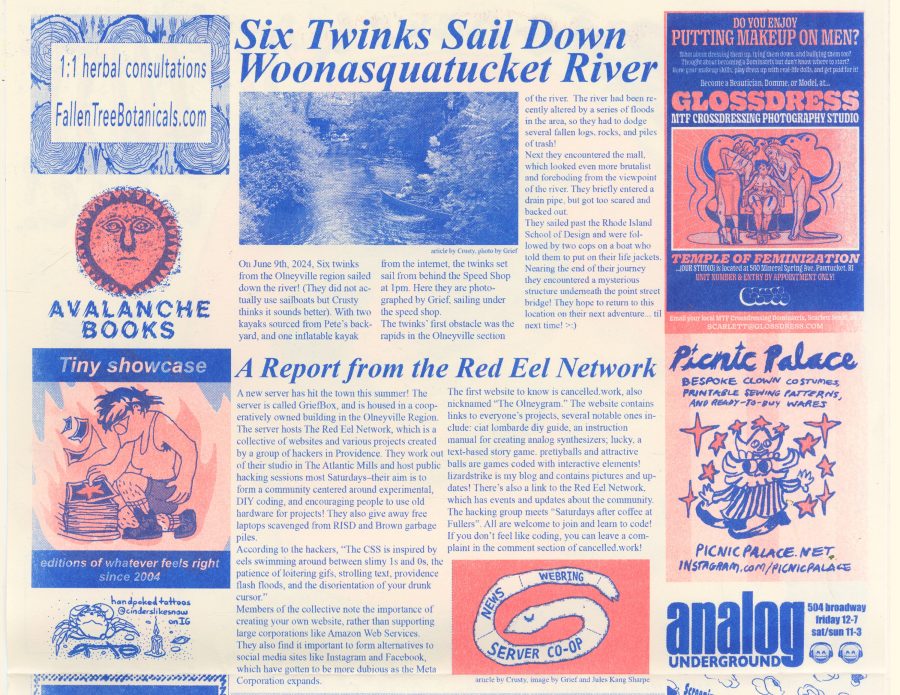
Artwork by: Jules Kang Sharpe.
AH: And like even just having this space for queer art, for community… have you felt the difference with that? Between this and other conventions you’ve tabled at?
MT: Yeah. Many zine fair attendants are already quite queer, but this one is just even more so, which is really cool. I also think it’s nice to just have a dedicated space for queer and trans exhibitors. It’s nice to know you’re going to see people that are like you.
JKS: And I feel like what comics have been in the past is mostly straight white dudes. So, I feel like having dedicated queer comics and queer art spaces is very rare and also important to have. Representation is really nice.
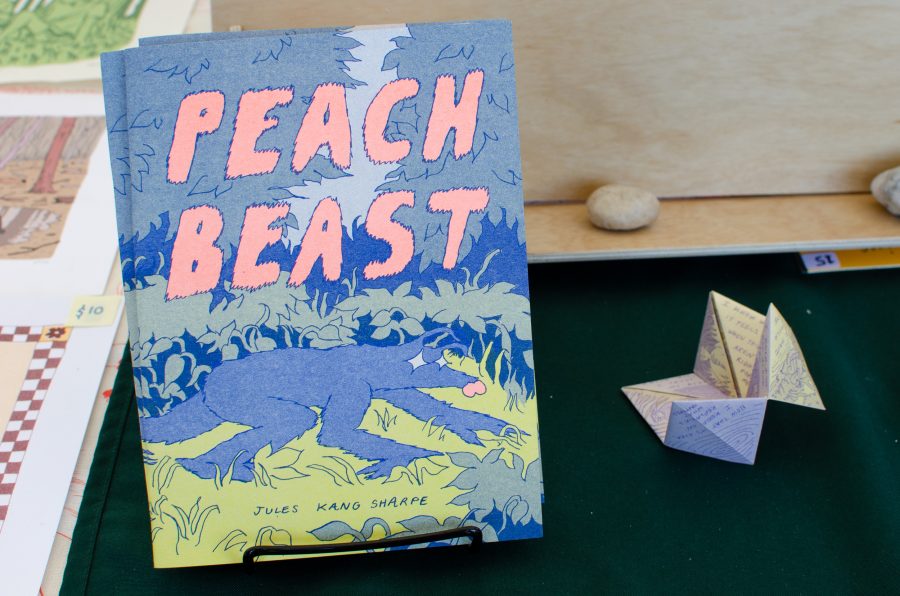
Image by: Anna Hu.



